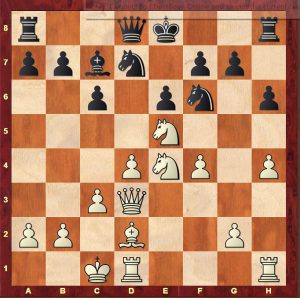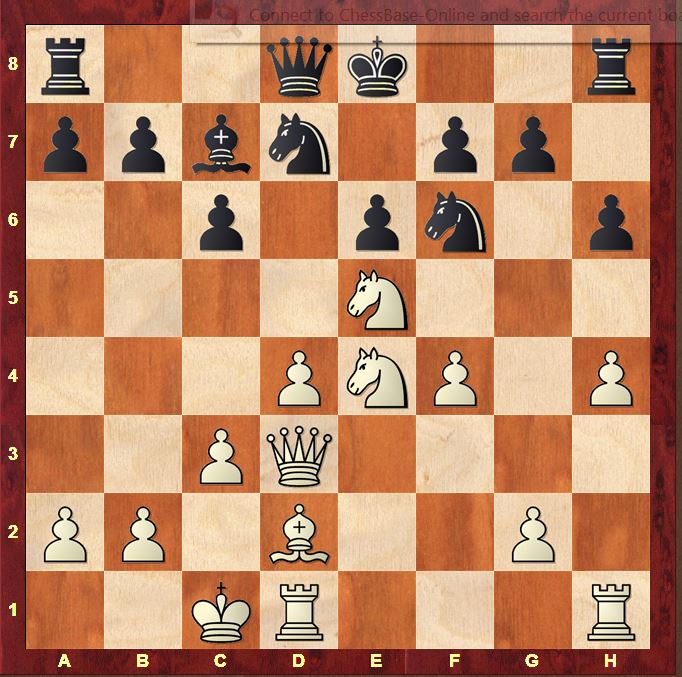One of my favourite themes is that of the side with too few pieces to cover its (too large) territory. I first came across it in a book I’ve mentioned many times already in this blog: “Best Play: A New Method for Discovering the Strongest Move” by Alexander Shashin. Shashin turns the conventional wisdom of exchanging pieces in a cramped position as a means of relieving pressure on its head… or rather gives it a positive and aggressive twist! He says that the more “compact” side should try to exchange off the pieces of the side with more space because the less “compact” side will inevitably have difficulty covering its extended terrain with fewer pieces.
I keep on collecting examples of this theme and I thought it might be nice to share 2 recent examples I came across.
The first example is taken from a game I played against the Dutch IM Riemersma at the recent Nova College weekend tournament in Haarlem.
Sadler,Matthew D – Riemersma,Liafbern
Haarlem Nova College 02.07.2016
1.e4 c6 2.d4 d5 3.Nc3 dxe4 4.Nxe4 Bf5 5.Ng3 Bg6 6.h4 h6 7.Nf3 e6 8.Ne5 Bh7 9.Bd3 Bxd3 10.Qxd3 Nd7 11.f4 Bb4+ 12.c3 Bd6 13.Ne4 Bc7 14.Bd2 Ngf6 15.0–0–0

I reached this position after 15 moves. After being surprised a little in the opening, I’d decided to offer Black a chance to win a central pawn in return for complications. Instead my opponent pursued a consistent and typical Caro-Kann course of minor piece exchanges.
15…Nxe4
15…Nxe5 16.fxe5 Bxe5 17.Nc5 Bc7 18.Nxb7 Qd5 19.c4 was what I was looking at. Black should be fine, but his shattered pawn structure introduces some randomness into the position.
16.Qxe4 Nf6 17.Qd3 Qd5
Once this position appeared on the board, I suddenly thought of Shashin’s theme. White’s territory is fairly large, stretching from the undefended a2 pawn to his structure with pawns on d4, f4 and h4 and the light-square gaps in between them. By exchanging a pair of knights, Black removes a defender of these squares and gives his queen the entry path and space to infiltrate in and dance around White’s pawn structure. White cannot prevent this, or drive Black’s queen back completely: the territory he needs to cover is just a little too large for the pieces he has left on the board.
18.c4 Qe4
Invading
19.Qg3 0–0 20.Rhe1 Qf5 21.Qf3 h5
Black has settled his queen on a comfortable square eyeing White’s porous light squares and has achieved comfortable equality.
The second example comes from the book “Bogolyubow – the fate of a chess player” by Sergei Soloviov. I’ve been playing through a lot of Bogolyubow’s games recently and the following game struck a chord:
Bogoljubow,Efim – Zubarev,Nikolay
URS-ch 1925
Black and White seem to have traded places as Black has a definite space advantage. Bogolyubow pursues a consistent policy of exchanging pieces until Black can no longer defend all the corners of his realm
18.fxe5 Nxe5 19.Nxe5 fxe5 20.Bg5 Rf8 21.Ne2 Ng8 22.Rxf8+ Bxf8 23.Rf1 Bg7 24.Nc1 Bf6 25.Qh4 Bxg5 26.Qxg5
The result of all these exchanges: Black still has the shell of his space advantage (his pawn structure on c5,d4 and e5) but with so few pieces left he can barely defend it. Notice once again the starring role for the opposing queen which again is the ideal piece to exploit the gaps of varying colour in Black’s position.
26…Ra7 27.Nd3 Re7 28.b4
A very nasty move and another typical procedure: opening up a second flank of attack
28…Re6
28…axb4 29.axb4 cxb4 30.Nxb4 Qxb4 31.Qxg6+ Kd7 32.Qxg8 is very good for White
29.bxc5 bxc5 30.Rb1
30…Nf6
30…Ne7 31.Qh6 and the queen infiltrates
31.Qxg6+ Kd8 32.Rb5 Nd7 33.Qxh5 Rf6 34.h3 Qe6 35.Qh8+ Ke7 36.Rb7 Qc6 37.Qg7+ 1–0



